Plastic is a versatile material that has several uses. It is practically everywhere in the modern world. However, there are serious health concerns attached to the use of plastic in general, and its use with food processing in particular. That extends to coffee makers as well.
Many people who buy a new coffee maker often complain about the “plastic taste” or smell in their coffee. Getting a plastic free coffee maker should fix that problem and other concerns that come with the use of plastic.
Top Non Plastic Coffee Makers For 2020
- Breville BDC450 Precision Brewer Coffee Maker
- Mueller French Press Double Insulated 310 Stainless Steel Coffee Maker
- Bialetti 6633 6 Cup Moka Pot
- BUNN VP17-1SS Pourover Coffee Brewer
- Coffee Gator Pour Over Coffee Maker
- SterlingPro French Press Coffee Maker
- Hario V60 Ceramic Coffee Dripper
- CHEMEX Classic Series, Pour-Over Glass Coffeemaker
- Farberware 50124 Classic Yosemite Stainless Steel Coffee Percolator
- Technivorm Moccamaster 59162 KBG Coffee Brewer
Editor’s Choice: BUNN VP17-1SS Pourover Coffee Brewer
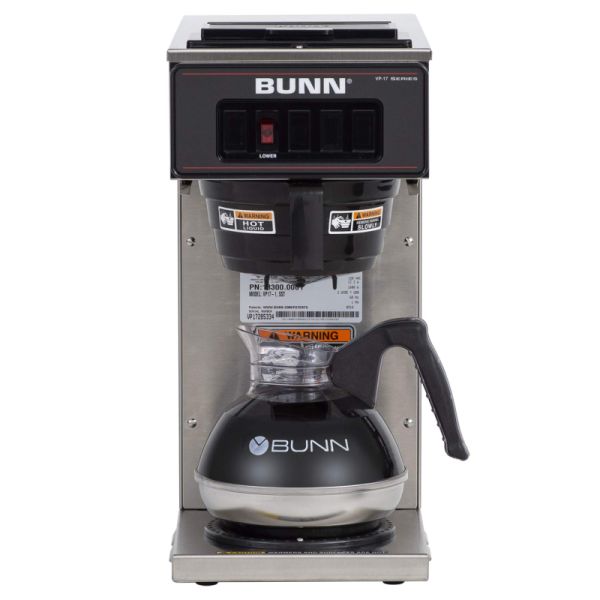
As drip coffee makers go, BUNN VP17-1SS Pourover Coffee Brewer isn’t the sexiest or most feature-rich coffee maker. It is, however, a coffee maker that can go plastic-free and deliver amazing coffee.
It’s a tall order to get a drip coffee maker that can actually be swayed from using plastic. Plus, it has other features that make it worth recommending. VP17 brews coffee pretty quickly and ensures that it is brewed right. Given its quality construction, the coffee maker has a long life and offers great value for money.
Review: 10 Awesome Plastic Free Coffee Makers
1. Breville BDC450 Precision Brewer Coffee Maker
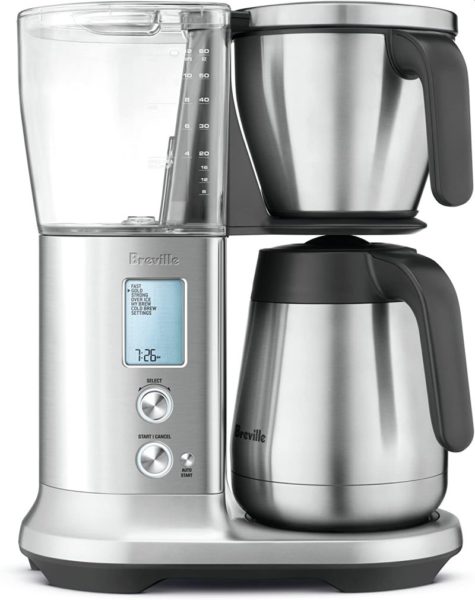
This is an impressive coffee maker that stands to the requirements of taste, features, and quality. It avoids the use of plastic, instead banking on the more reliable stainless steel. Breville BDC450 Precision Brewer is an SCA certified coffee maker and capable of brewing a mean cup of coffee.
Several brewing options are available, including preset options and customizations. In the “gold cup” preset mode, the coffee maker adjusts its temperature and brewing requirements to meet SCA requirements.
A key component here is the PID system that ensures water temperature stays in line with user requirements. Customizations are available for flow rate and brew time so you can get your brew exactly how you prefer it. Options are also available for “over ice” and “cold brew”, thus allowing a wider range of beverages.
Fine-tuning settings is as easy as rotating the attached switch to reach preferred parameters. A small LED screen shows relevant options for brewing. To pacify more specific tastes, the coffee maker includes flat bottom and cone filter baskets. Should these not catch your fancy, it is compatible for use with popular pour over coffee makers like Hario V60 and Kalita Wave.
Pros
- High-quality construction
- PID system allows precise temperature control
- Preset modes as well as easy customizations
- Compatible with pour over coffee makers like Hario V60 and Kalita Wave
- SCA certified
- Has a 60oz water reservoir for large batches of coffee
- Can brew small batches, going as low as a single cup
Cons
- Expensive
- Included carafe doesn’t completely seal its lid
2. Mueller French Press Double Insulated 310 Stainless Steel Coffee Maker
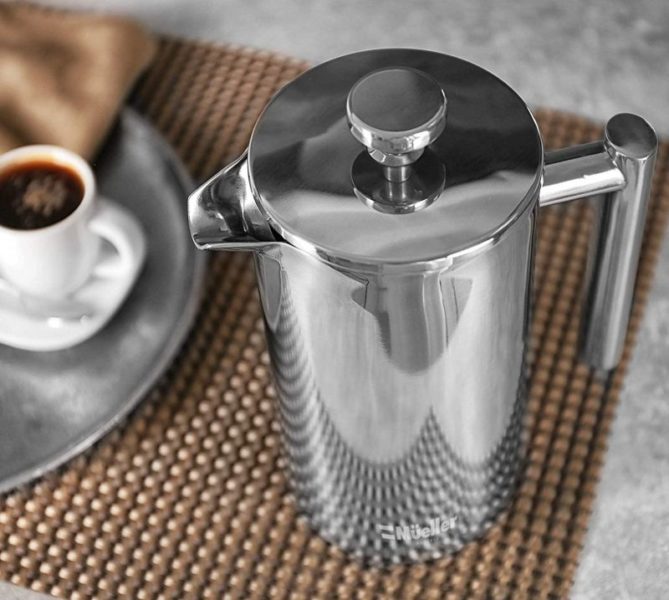
Though drip coffee makers are more technologically advanced and automatic, they can’t go plastic-free the way a French press can. Mueller French Press Double Insulated 310 Stainless Steel Coffee Maker doesn’t have any plastic components. It’s made from high-quality stainless steel and is all set to brew a great cup of joe.
The carafe/pitcher of this French press is double-walled, thus allowing it excellent insulation. That means you don’t have to worry about your coffee going cold while waiting 3-5 minutes for the brewing process. In fact, it is quite capable of keeping the brew hot for an hour. If you choose that, remember to remove the coffee grounds to avoid over-extraction.
Much like the carafe, the plunger and filter too are made entirely out of metal. This French press has a triple-layer filtration system to keep out the grinds from the coffee. When you really want a coffee maker without any plastic, this is the option to pick.
Don’t see it as an inferior option to drip coffee makers simply on operation. French press vs drip coffee is a pretty close call.
Pros
- High-quality stainless steel construction
- Double-wall insulation keeps coffee hot
- Triple-layer filtration keeps coffee grinds out (some fines will be present)
- Can last a long time
- Metal, nonplastic coffee maker
Cons
- Heavy
- Double-wall insulation won’t allow it to be placed on a stove
3. Bialetti 6633 6 Cup Moka Pot
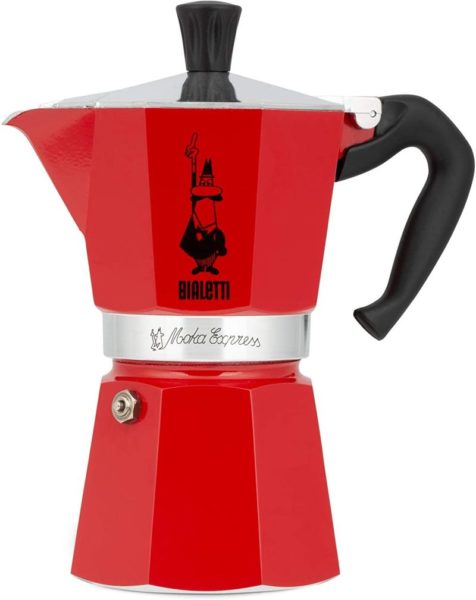
Bialetti Moka Pots are pretty much the standard for those of us brewing moka coffee. The pots are generally made from steel or aluminum (this one’s aluminum). There is no use of plastic within the coffee brewer. Although the handle and lid holder use plastic, they never come in contact with the coffee.
Overall, this is a quality machine with proven credentials. Plus, it’s a great way to make a kickass strong coffee on the stovetop.
Pros
- Quality construction
- Can make strong and bold moka coffee
- No plastic used for the coffee maker
Cons
- Limited usability
- Can’t be cleaned in a dishwasher
Check buying options, colors, and discounts
4. BUNN VP17-1SS Pourover Coffee Brewer – Editor’s Choice
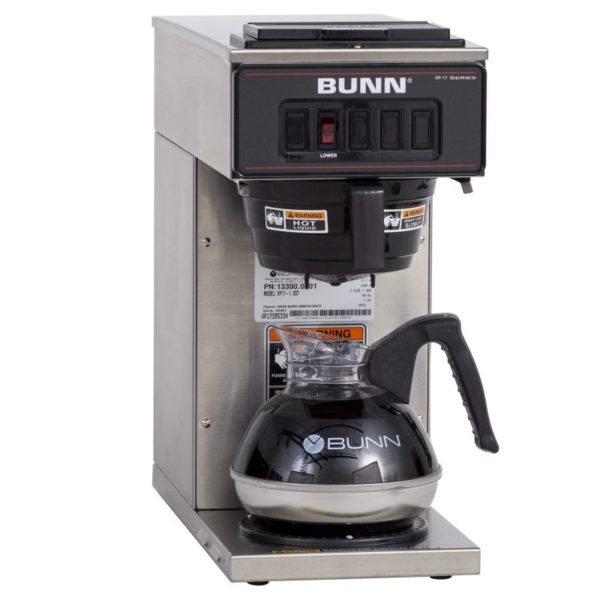
If a plastic-free coffee maker is what you want, this is your safest bet. BUNN VP17-1SS Pourover Coffee Brewer is well-regarded for its quality construction and fast brewing speeds. VP17 has an all stainless steel construction so the hot water and coffee never come in contact with plastic.
It can be used as a home coffee brewer or easily switch its duties to a commercial setting. The coffee maker is capable of brewing 14.4-liters of coffee per hour. Not that an average home user would ever need it, but the implication of fast-brewed coffee is very clear.
While the internals are all steel, the machine does have a plastic control panel. That isn’t a problem for our current requirements and it is better to have an insulator like plastic there. The bigger problem is that its filter basket is made from plastic. BUNN offers a workaround to that problem, with a stainless steel filter assembly.
This option formed a big part of choosing BUNN VP17 as the editor’s choice for this category. This coffee maker can go completely plastic-free as a drip coffee maker, which is practically rare. Using the steel filter does push up the costs a bit, it doesn’t go overboard. Also, with commercial features and long life, this coffee maker is well worth the expense.
Pros
- Completely plastic-free drip coffee maker
- Quality construction that can last for several years
- Quick to brew coffee
Cons
- Slightly expensive, though with good value for money
- Dated design and unimpressive looks
5. Coffee Gator Pour Over Coffee Maker
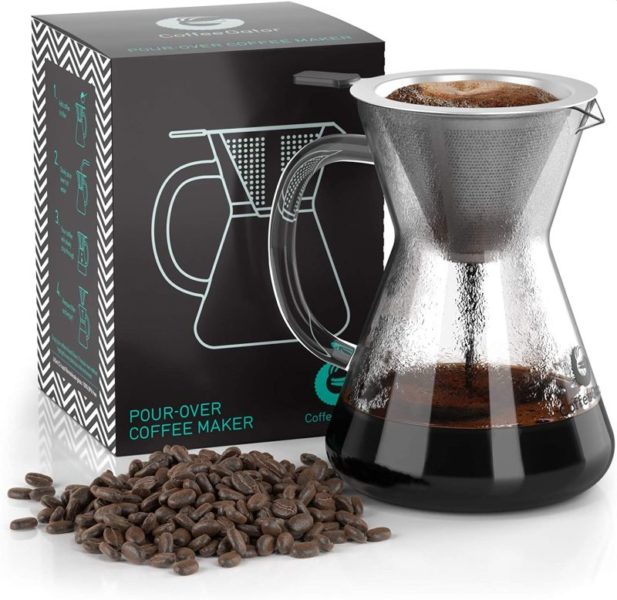
Pour over coffee makers can get away easily without using plastic components. They can push down costs by switching to plastic but that’s usually not the path for high-quality coffee makers. Coffee Gator Pour Over Coffee Maker has a glass carafe with a metal filter. Quality pour over coffee makers with a carafe usually are glass coffee makers like this one.
The biggest downside of this coffee maker is that the glass carafe is rather thin and seems fragile. Be careful while handling it. There isn’t much to worry about the laser-cut metal filter – it will easily last years.
Pros
- Good quality construction
- Simple and easy to use
- The included stainless steel filter is pretty good
Cons
- The glass carafe is a fragile
6. SterlingPro French Press Coffee Maker
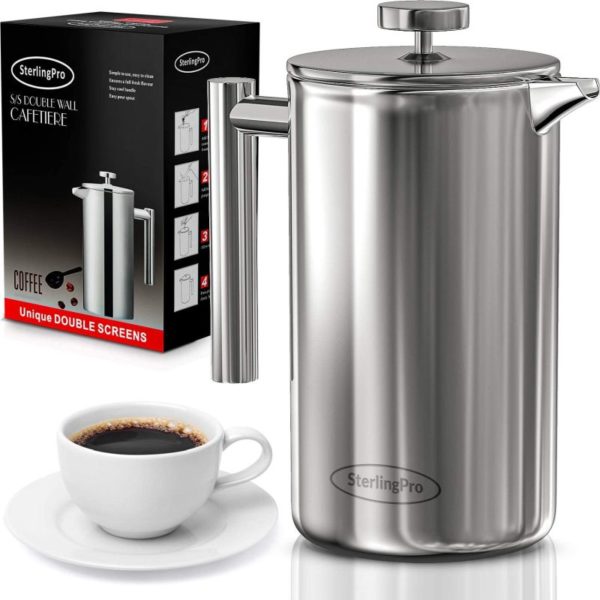
SterlingPro French Press Coffee Maker is quite similar to the Mueller French Press we see on this list. The stainless steel coffee maker has a double-wall construction so it will keep your coffee hot for longer. The filtration system too is made from stainless steel and does a pretty good job at keeping even the finer grounds out of your coffee.
Pros
- High-quality stainless steel construction
- Double-walled carafe keeps the coffee hotter for longer
- Capable filtration system keeps most of coffee grounds out of the brew
Cons
- Can’t be put on the stove
- Heavy
7. Hario V60 Ceramic Coffee Dripper
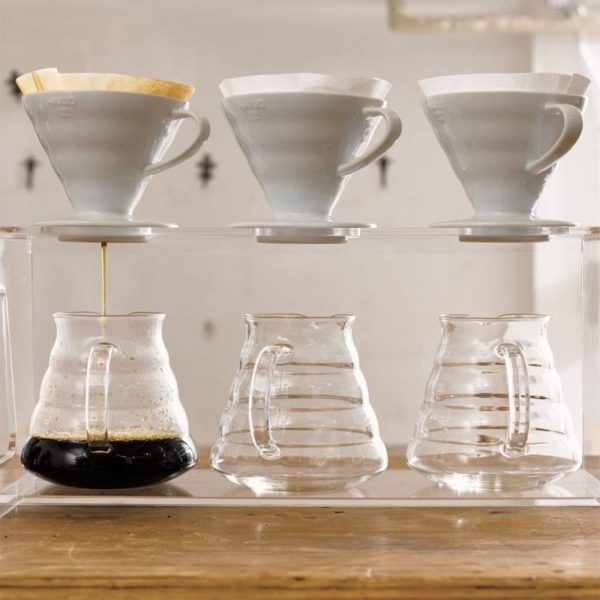
Hario V60 is extremely popular and one of the key drivers of the rise of pour over coffee. The coffee dripper is available in a variety of materials, including ceramic, glass, metal, and plastic. With all the other options available, it becomes convenient and easy to skip plastic and pick a better material.
The deceptively simple design of the Hario V60 makes it easy to use. It’s also useful in extracting flavors from the coffee. Hario V60 and the pour over method often work great to get floral and fruity notes from the coffee. The extraction process maintains a healthy acidity.
Ribs on the cup are arranged in a vortex that encourages better extraction and prevents the filter from sticking to the walls. There’s a single hole at the bottom of the V60 to allow the filtered coffee to drip through.
Pros
- Well-designed and constructed with quality materials
- Available in a choice of several materials and colors
- Easy to use
Cons
- The single hole can feel oversized and in some cases may drain the coffee to quickly
8. CHEMEX Classic Series, Pour-Over Glass Coffeemaker
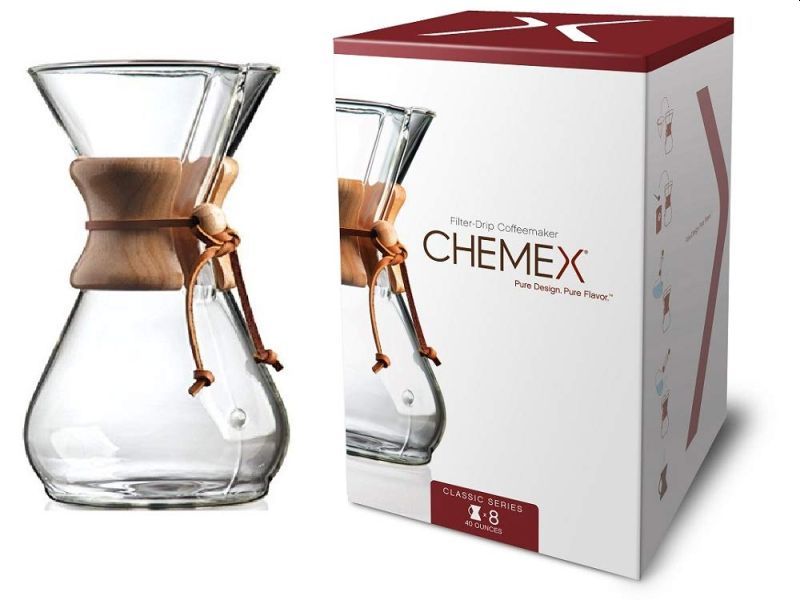
Chemex pour over is the leader for carafe-style pour over coffee makers, much like Hario is for cup-style pour over coffee makers. The high-quality glass carafe is made from non-porous Borosilicate glass. It won’t absorb flavors or aroma from the coffee, neither will it add flavor or odor of its own.
A wooden collar is placed on the neck of the coffee maker, allowing easier maneuvering. Since this is also the area where the filter is placed, it can get pretty hot. Having an insulator there is helpful and practical.
Chemex Classic uses paper filters. This means you get a clearer cup of coffee as paper is better at stopping fine grounds than metal filters. Paper will also absorb oils from the coffee. Depending on the filter you use, there may also be other changes in flavor and taste.
This is not to say that one filter is essentially better than the other. Your personal preference can be the guiding force in choosing the filter and coffee maker.
Pros
- Good looks and quality construction
- Borosilicate glass is non-porous and doesn’t affect flavor or aroma
- Brews great-tasting coffee
Cons
- More expensive than competitors
- Can be somewhat tedious to clean
9. Farberware 50124 Classic Yosemite Stainless Steel Coffee Percolator
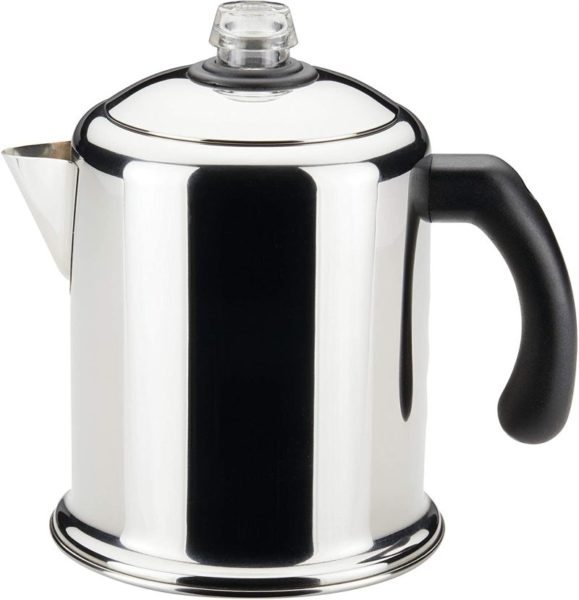
This stovetop percolator is made from heavy-duty stainless steel and is built to last. Farberware 50124 Classic Yosemite Stainless Steel Coffee Percolator has a mirror finish and is topped by a clear glass knob. A filter basket is included with the percolator for greater ease and convenience of use.
The construction and design are fairly simple. The manufacturer has been careful to handle the basic problems and has been careful to address them. This coffee percolator is dishwasher safe and fully immersible since it doesn’t have any electrical components.
Pros
- Sturdy, solid, all-steel construction
- Includes filter basket
- Easy to use
Cons
- The glass knob top can be a bit fragile
10. Technivorm Moccamaster 59162 KBG Coffee Brewer
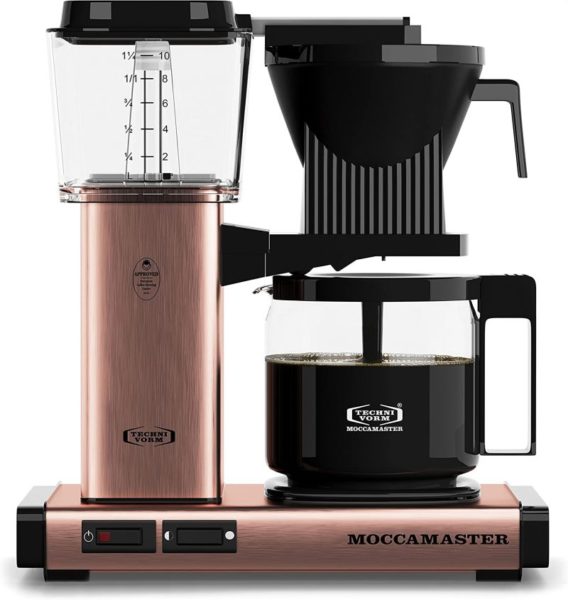
Okay, first things first, this isn’t entirely a plastic free coffee maker. Technivorm Moccamaster 59162 KBG Coffee Brewer is in this list as a representative of coffee makers with some plastic parts.
Since plastic is so commonly used, these coffee makers make use of plastics without the potentially harmful substances. Generally speaking, these are phthalate-free and BPA-free plastics. There is a tiny number of drip coffee makers that don’t use any plastics. However, there is a somewhat broader range of coffee makers that use BPA-free plastics.
Technivorm Moccamaster 59162 KBG Coffee Brewer uses plastic for its water reservoir and filter basket. They’ve been careful to use BPA-free plastics that are better employed for such purposes. This is an SCA certified machine that brews coffee to the golden cup standards of the organization.
As such, it is capable of heating water to the ideal extraction temperature and holding the temperature during the brewing process. A copper element heats the water to the right temperature and does it with dexterity.
On its part, the brew-basket includes an auto drip-stop function to avoid spills and similar issues. Separate switches are available for the coffee maker and the heating plate. This is a quality machine with high-grade parts and excellent technology. Even with all that, however, the plastic used is still flimsy, which isn’t expected from a coffee maker in this price range.
Pros
- Brews an excellent cup of coffee
- SCA certified
- Available in several color options
- High-quality construction and long warranty
Cons
- Uses plastic parts
- Expensive
See buying options and discounts
About Plastic Free Non Toxic Coffee Makers
As we said earlier, plastic is everywhere. The versatile material is tough to avoid for use in drip coffee makers and similar machines. Especially so for coffee makers where cost and weight are a factor. While stainless steel and aluminum can be used, they drive up the cost and weight of the machine.
Meanwhile, plastic is versatile and low cost, leading to easy application in coffee makers. Its use is a reason why new coffee makers often cause that weird plastic smell and taste in coffee. The problem often is BPA – the chemicals used during the manufacture of plastics.
At sufficient temperatures, it can leach into food (or water, in the case of coffee makers). BPA is an endocrine disruptor and can cause health issues. If you suspect its presence in your coffee maker, that’s reason enough to junk it.
Another problem is the use of phthalates, which can cause multiple health problems and are carcinogenic. Their use is very rare and unlikely in coffee makers. Still, it is something to be wary of.
BPA Free Coffee Maker And Its Wider Use
Concerns related to BPA in plastics have resulted in the increased adoption of BPA free coffee makers. Simply put, these coffee makers use plastics that have not been treated with harmful substances like BPA.
Many of these use plastics that come into contact with hot water or coffee. However, the plastic used doesn’t leach harmful chemicals into the water or coffee. Of course, some sections continue to be concerned about the presence of some other chemicals in the plastics.
If you’re buying a coffee maker, at the very least, make sure it is BPA free.
I’ll also suggest avoiding cheap no-name brands when considering non toxic coffee makers. It doesn’t take much to print “BPA free” on the box and there are plenty of unethical businesses that take advantage of such terms. Established brands are unlikely to indulge in such practices.
The Stainless Steel Coffee Pot As The Choice
Stainless steel coffee pot or coffee maker is the best candidate when choosing a non toxic coffee maker. Stainless steel is non-porous and doesn’t react with hot water or coffee. As such, it is an ideal, and perhaps healthiest choice. The negative side is that it can make your coffee maker bulkier and more expensive.
As you see on our coffee maker selection here, there’s a greater focus on stainless steel coffee makers. It is the superior material to pick. While the material is fairly common in higher-end espresso makers, it isn’t as widely used in lower-end coffee machines. As we see, many of the relatively expensive drip coffee makers too can’t quite move fully towards stainless steel.
The requirement is that parts that come into contact with hot water be stainless steel (or a similar inert material). Machines that have panels or external coats of stainless steel don’t count. It is the innards that matter in picking a plastic free coffee maker.
Stainless steel is also useful as a mold free coffee maker. The material itself isn’t conducive to the growth of fungi. Of course, this assumes the coffee maker is clean and well-maintained. The presence of impurities or dirt left behind by brewing can become a breeding ground for mold.
Should I Use A Glass Coffee Maker?
As non-toxic coffee makers go, glass is a pretty good choice. The use of this material is limited by its properties. It isn’t practical to have interiors of a drip coffee maker made of glass. There are plenty of other options though.
Glass coffee maker is a pretty popular choice with pour over and French press coffee makers. Quality construction of glass ensures it doesn’t add or absorb flavors and aroma from coffee. Higher quality materials like borosilicate glass can be very non-porous and convenient for use.
The biggest risk with glass is its fragility. These coffee makers remain at risk of breaking from any kind of rough use.
FAQs Related To Plastic Free Coffee Makers
Do Bunn Coffee Makers Have Plastic Parts?
The use of plastics in BUNN coffee makers varies with each model. Some, like the BUNN VP17-1SS listed here, can be completely plastic free. That means hot water and coffee never come into contact with anything plastic.
Many Bunn models also offer after-market metal filter baskets. This way, plastic never comes in contact with the coffee. Plastic is still used in other locations, like the control panel. Though that is not relevant to the use or brewing of coffee.
Others may have varying degrees of plastic. Bunn uses NSF (National Sanitation Foundation) grades of plastic, which are not known to leach any harmful chemicals into the water/coffee.
Is Plastic In Coffee Makers Safe?
That really depends on the coffee maker and the type of plastic used. It is preferable that plastic never comes in contact with water or coffee. However, if that is not possible, it is necessary that the plastic not leach any chemicals into the water/coffee. If in doubt, check the labels on the box or contact the manufacturer to ensure that plastic in the coffee maker is safe.
What Is The Healthiest Coffee Maker?
High-quality coffee makers that are non toxic and don’t leach chemicals into the coffee/water are the healthy choice. If the presence of chemicals is a concern, you can choose coffee makers that have a stainless steel construction.
Is There An Automatic Drip Coffee Maker Without Plastic Parts?
Automatic drip coffee makers without plastic are a somewhat rare breed. The closest to these requirements is the Breville BDC450 Precision Brewer. While it lacks some functions of an automatic brewer, BUNN VP17-1SS is a good choice as well.
What Kind Of Plastic Is Used In Coffee Makers?
Responsible coffee makers choose BPA-free plastics for their coffee makers. In most cases, the brew basket is made from ABS plastic, while the water tank utilizes polypropylene. Both of these are non toxic, BPA-free materials.
Do K Cups Have BPA?
Keurig has confirmed that K cups are BPA-free. However, Keurig isn’t the only manufacturer of K cups. So if you’re buying from a different company, ensure that the cups are BPA-free.
Is The Hamilton Beach BrewStation BPA Free?
Yes, Hamilton Beach has confirmed that any parts of the BrewStation that come in contact with water or coffee are completely BPA free.
Get A Healthier, Non Toxic Coffee Maker
While it is a useful and versatile material, not all types of plastic should come in contact with food or edible items. Getting a plastic free coffee maker is a good choice. Some plastics can leach harmful chemicals like BPA into water or coffee, and thus cause health issues.
My top recommendation here is the BUNN VP17-1SS Pourover Coffee Brewer. If you want more options in brewing coffee, consider the Breville BDC450 Precision Brewer Coffee Maker. For a different option, consider the Chemex Classic Series, Pour-Over Glass Coffeemaker.
